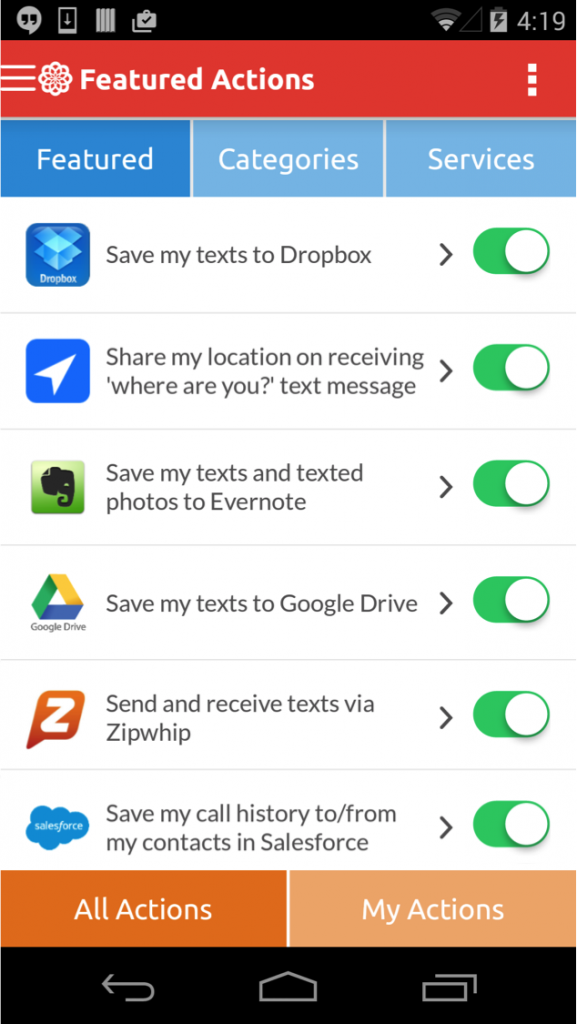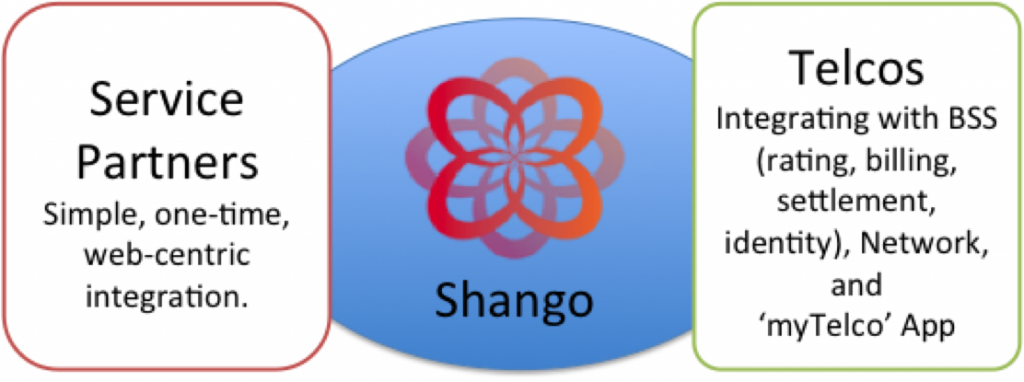 The Shango team have an impressive history spanning over 6 years in building and integrating telecoms and web backend systems. They built the back-end-as-a-service platform business that One Source Networks’ bought last year, and the team have spent over two years building their new platform that bridges the telephone network and the web.
The Shango team have an impressive history spanning over 6 years in building and integrating telecoms and web backend systems. They built the back-end-as-a-service platform business that One Source Networks’ bought last year, and the team have spent over two years building their new platform that bridges the telephone network and the web.
The good old telephone network is one of the platforms we communicate on the most, but all the stuff that happens there remains frustratingly trapped in silos or ephemeral. This should not be the case as telephony is one of the few communication networks that do not need to reside in a silo. Whatsapp, WeChat, LINE, etc. all keep their users in their silo as their business model is based on attention, hence being closed is key to retaining attention. A Telco’s business model is different, the customer pays.
Put simply, all your calls, texts, voicemails and even your phone number are ‘trapped’ in the phone network. Shango sets them free so you can do lots of cool stuff with one simple Action. The screen shot below shows some of Shango’s Actions. And at the end of this weblog is a longer list of use cases made possible.
 Its easy to see how Shango Actions could be part of the “myTelco” app most operators have deployed. Making it easy for customers to add services and personalize their communications experience. The telephony network has unique capabilities, its in the call path, so its sees all the communications content. Which means it works for any device or end-point, that is its device independent. Most internet-based communication services are peer to peer, which limits the service’s access to the content of communications, even for messaging synchronization between the same client across your devices can be hit and miss.
Its easy to see how Shango Actions could be part of the “myTelco” app most operators have deployed. Making it easy for customers to add services and personalize their communications experience. The telephony network has unique capabilities, its in the call path, so its sees all the communications content. Which means it works for any device or end-point, that is its device independent. Most internet-based communication services are peer to peer, which limits the service’s access to the content of communications, even for messaging synchronization between the same client across your devices can be hit and miss.
The phone number is quite a useful identity, most internet-based communication services use the telephone number identity today. And its an identity linked to a way to pay thanks to carrier billing. There’s gold to be mined from the telephone network. Given this potential, why hasn’t it been extensively mined already? At this point I’ll avoid getting into a rant on IMS (IP Multimedia Subsystem), RCS (Rich Communications Suite), dumbass telco billing fees (some still say revenue share, argh!), self–focused thinking on APIs and CRM (myTelco) apps, and a host of other issues that have wasted a decade.
But back to the focus of this weblog, Shango provides BOTH the services through their service partners AND the glue between services on the web and in the telco’s network. With the necessary adaptors to the network, business support systems, and myTelco app; which is Shango’s pedigree.
The key is to understand the category of problems Shango solves: linking services on the telephone network and the web, and solving the integration issues between them as a neutral third party, as shown below. Shango are currently in trials across 12 countries. With a very simple opening proposition of keeping telecommunications relevant in today’s web-centric world, an interesting way to enable some simple bundling of web-based and new communication services, and doing it in an easy way for customers to Action.
The impact of linking the communications content, triggers and phone number with the web opens up a surprisingly large number of use cases, some of which are listed below. This taxonomy is divided into 2 main group, linking the core telephony services with web services (group 1), keeping telephony relevant in today’s web-centric world; and linking the telephone number (carrier billing) to new communication and web-based services (group 2), driving new revenues. Group 1 is further broken into communications content related services, as the telephone network is uniquely in the call path; and communications triggered events. Group 2 is divided between new communication services and web-based service bundles, which now become just a click away with Shango’s Actions.
The Shango team will be at MWC, click here to book a meeting.
- 1) Linking voice, SMS/MMS, and voicemail content with web services
- 1A) Communications Content Related Services
- Capability: SMS / MMS can now be exchanged with web-based services, and here are some example use cases:
- A business person can search more of their customers’ messages, rather than wasting time searching in the wrong silo for a message.
- Photos received by MMS from family members are now stored with all their family photos, and not lost when changing phones.
- Messages from customers are stored in the company’s preferred Sales support software, no customer questions / responses are lost.
- Capability: call history, audio files of calls and voicemails, and even off-line speech to text is available for web-based services, and here are some example use cases:
- Sales people hate filling forms; calls and the content of the calls are automatically uploaded to services like SalesForce.com. This saves the sales person’s time to do more sales, and improves the business’s intelligence on how to sell better.
- A business person can search more customer communications, to check the customer was contacted after an update was sent to ensure satisfaction.
- Record conversations with loved ones to remember them in the future.
- Record conversations with the kids to hold them to promises made and then broken on what time that said they would be home!
- Capability: SMS / MMS can now be exchanged with web-based services, and here are some example use cases:
- 1B) Communications Triggered Services
- Capability: Automatic responses to common txt messages, and here is an example use case:
- If one of your family sends you an SMS with “where are you?” an automatic response with your location is sent. How often are we left guessing on the whereabouts of a loved-one, now the reply is instantaneous.
- Capability: Automatic txt response to incoming calls given specific context, and here are some example use cases:
- While driving, an automatic reply to txt/calls is “I’m driving at the moment, my reply will be delayed.”
- While on a call an automatic txt is sent to calls from other mobiles, “I’m on a call, let me know when you’re free to chat.”
- Capability: Other call treatment options, and here are some example use cases:
- Fed up of marketing and sales calls? Forward them to a premium number where they have to pay to talk to you.
- You do not answer a call from a number 5 times; subsequent calls are automatically diverted to voicemail.
- Capability: Automatic responses to common txt messages, and here is an example use case:
- 2) Linking the Telephone Number (and carrier billing) to New Communication and Web-based Services
- 2A) New Communication Services
- Service: Bettervoice that adds IVR and PBX capabilities to any telephone number, mobile/virtual number, or voicemail system.
- When a call comes into a small business, someone answers it, sales are not lost and customer service is improved.
- Small businesses can now appear like a big business, with a simply web and telephony based service.
- Service: ZipWhip enables cloud texting from any device
- Text from your laptop while working in the office, just like with Whatsapp and Wire web clients.
- Text from Facebook Messenger using your mobile number.
- Service: Temporary Number.
- For classified sales, use a temporary number so once the sale is made no further calls are completed.
- Service: Family Smart Limits.
- Control kids texting and phone use during school and night-time.
- Service: dondeEsta, family peace of mind services.
- Know where the kids are, be alerted when they reach schools / home.
- Know where the car is when your children borrow it.
- Service: Bettervoice that adds IVR and PBX capabilities to any telephone number, mobile/virtual number, or voicemail system.
- 2B) Web-based Service Bundles (using carrier billing and zero-rating)
- Capability: Bundling up data, payment and web-based services, all actioned from just one click with Shango Actions.
- Simple bundles of popular web-services such as Spotify, ESPN, HBO Go, Sky Sports, Netflix, Pandora, Dropbox, Evernote, etc. which uses carrier billing and zero-rates data used for the service.
- Capability: Bundling up data, payment and web-based services, all actioned from just one click with Shango Actions.

Good review. Shango’s executive team are visionaries and they back up their words with functional products. I’ve seen the demos and can report that they’ve come up with a completely new user experience that makes a lot of sense. Impressive!
Ivelin